While investigators are hard at work determining what caused the crash of Asian 214, the factors that led to other land short accidents are known and may hold clues that could shed light on what happened in San Francisco. As I watched the news coverage that day, I couldn't help noticing how eerily similar the accident was to several, not so distant events. Today's post is not intended to be an explanation of what happened to Asian 214, but rather an overview of similar accidents.
BA38
The first that entered my mind was British Airways flight 38, a Boeing 777 that crashed short of runway 27L at London Heathrow on January 17, 2008. There were no fatalities as a result of that accident but 47 people sustained injuries and the aircraft was the first Boeing 777 hull loss since the type entered service in June of 1995.
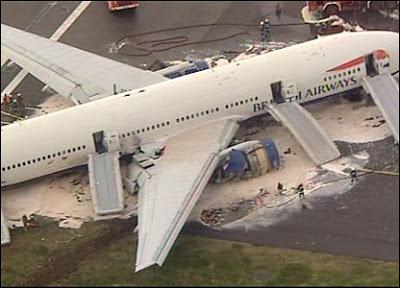
The AAIB, the UK Air Accidents Investigation Branch, released an initial report on January 18 which stated the following: “Initial indications from the interviews and Flight Recorder analyses show the flight and approach to have progressed normally until the aircraft was established on late finals for Runway 27L. At approximately 600 ft and 2 miles from touch down, the Autothrottle demanded an increase in thrust from the two engines but the engines did not respond. Following further demands for increased thrust from the Autothrottle, and subsequently the flight crew moving the throttle levers, the engines similarly failed to respond. The aircraft speed reduced and the aircraft descended onto the grass short of the paved runway surface."
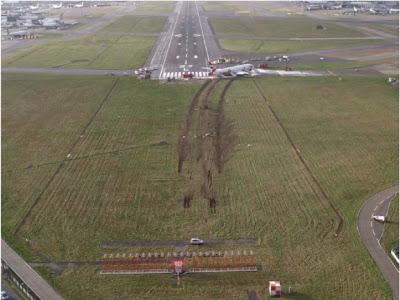
In many, if not most airline accidents, retrieval of data is a significant barrier to the process. However, with BA38 investigators had an intact aircraft...they had the pilots and crew...they had the passengers...and most importantly they had the Flight Data Recorder and the Quick Access Recorder which contained additional and easier to access data than that contained within the FDR. But even with so much information and evidence on hand, the AAIB eventually determined that the cause of the accident was long gone by the time rescue personnel arrived and was certainly nowhere to be found once the they started their investigation.
As with any accident, investigators quickly began crossing off possible causes, but zeroed in on fuel and fuel supply within the first days of the investigation. Fuel waxing was an early consideration. Flight 38 flew from Beijing, China to London Heathrow by way of northern Siberia where the aircraft was subjected to an extremely cold air mass...the coldest air temperature during flight was recorded at -74 Celsius. As you might imagine, fuel temperature is a significant concern in such extreme conditions and the crew monitored fuel temperature closely, noting that the fuel never dropped below the minimum threshold.
When jet fuel begins to freeze, it produces wax. As temperature drops, the wax increases until a point when it can longer flow through the fuel system. But through FDR recordings and interviews with the crew, it was confirmed that fuel temperature never dropped below limits and increased normally during the descent for landing. Fuel waxing was eventually ruled out as a possible cause.
The AAIB was stumped. It was determined that both engine's fuel metering valves had been fully open, but the engines did not get the fuel they needed. There was no problem with on board computers. There was plenty of fuel on board and there was no problem with the fuel itself. For many months, as Boeing 777s continued passenger service around the world, there was no clear explanation as to what could have happened. What could have been there at the time of the accident that wasn't there during the investigation?
Ice...and specifically the Fuel Oil Heat Exchanger became the focus of attention. Keeping fuel at an acceptable temperature has been a concern for aircraft builders and operators since the jet age ushered in flight at high altitudes and excessively cold temperatures. Early on, engineers devised a plan to warm fuel with engine oil. Cold fuel runs through thin tubes inside the FOHE that are surrounded by hot oil used to lubricate the engines. The exchange of heat inside the FOHE keeps the fuel warm enough to prevent the formation of significant levels of ice.
Below is a simplified diagram of how the FOHE works. Fuel enters and passes through tubes housed inside the heat exchanger. Engine oil, heated while performing its job of lubricating the engine, flows over the fuel filled tubes heating the fuel within. Heated fuel exits the FOHE and is metered into the engine at the desired rate.
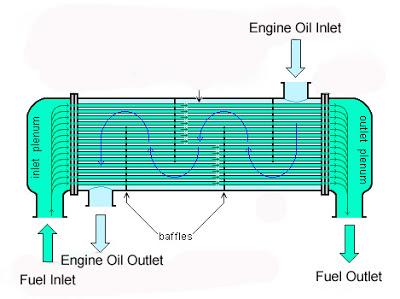
But what if ice formed before the heater? It was later determined that under certain conditions, ice crystals would form on the inside walls of the fuel lines during long periods with constant power settings. A subsequent sudden demand for power could cause soft ice in the fuel lines to break free from the fuel line and clog the FOHE, restricting fuel flow to the engines. It was a specific design flaw with the FOHE on Rolls Royce Trent powered engines that produced the scenario allowing this to happen.
The photos below show differing amounts of ice at the face of the Fuel Oil Heat Exchanger. It's difficult to see in the pictures, but the small tubes, through which fuel is intended to flow, protrude slightly above the face of the FOHE. The tubes are heated by engine oil as it passes around the tubes, but the tubes were not heated in the short distance that they extended above the face. Ice in small quantities was able to enter the tubes and melt as it passed through the FOHE, but when a large amount of soft ice hit the face at once, as it did with BA38, the ice would build up on the unheated inlet and block fuel from flowing to the engines.
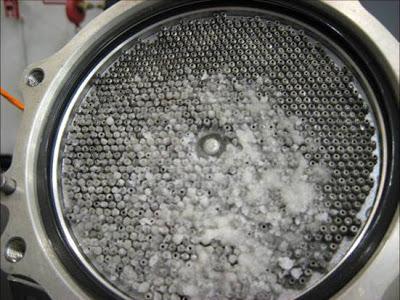
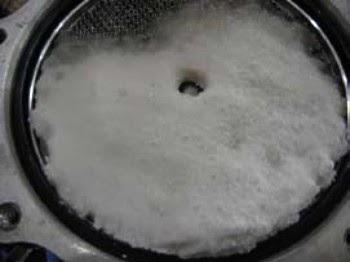
Ice at the face of the FOHE. Photo: AAIB
As it relates to Asiana 214, the flaw has long since been corrected on Rolls Royce engines...plus, the aircraft involved in the Asiana crash utilized entirely different engines manufactured by Pratt Whitney. Those engines incorporate a different FOHE design that is not susceptible to the formation of ice. While both accidents initially appear similar, the root causes are almost definitely unrelated. It is not believed that an event similar to BA38 is to blame for the crash.Check back next week for a discussion on the crash of Turkish 1951, a Boeing 737 that crashed while attempting to land at Amsterdam Schiphol Airport in 2009.
